Plectranthus mzimvubuensis
Plectranthus mzimvubuensis Van Jaarsv.
Family: Lamiaceae
Common names: Mzimvubu spurflower, Mzimvubu plectranthus (Eng.); Mzimbuvu-spoorsalie (Afr.)
Introduction
The Mzimvubu spurflower, has striking, aromatic foliage, and pink flowers borne on long, reddish stalks in late summer and autumn, giving it a pleasing appearance. This is a rare, cliff-dwelling species known from one population on the Mzimbuvu River in Eastern Cape.
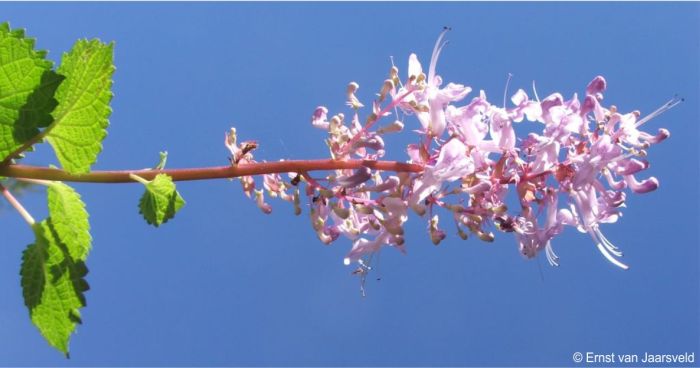
Description
Description
Plectranthus mzimvubuensis is a perennial, much-branched, scrambling shrub growing to a height of about 1 m and a width of 3 m. The roots are fibrous to slightly fleshy and bear oblong to rounded grey tubers, 25–50 x 14–20 mm. The young stems are herbaceous and semi-succulent, but become harder as the plant matures. The stem is smooth, grey, 4-angled, cylindrical in older growth, with a succulent basal caudex.
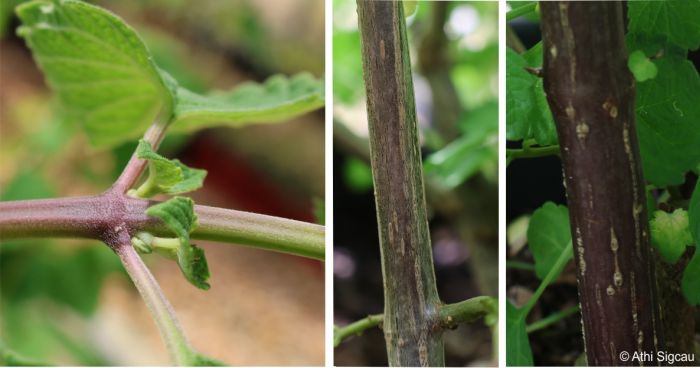
The leaves are pleasant looking, light green, thin-textured, broadly egg-shaped to triangular to almost rounded, 25–50 x 28–50 mm, with distinct venation, the margin toothed (dentate). The petioles are reddish purple, 10–20 mm long, covered with minute hairs.
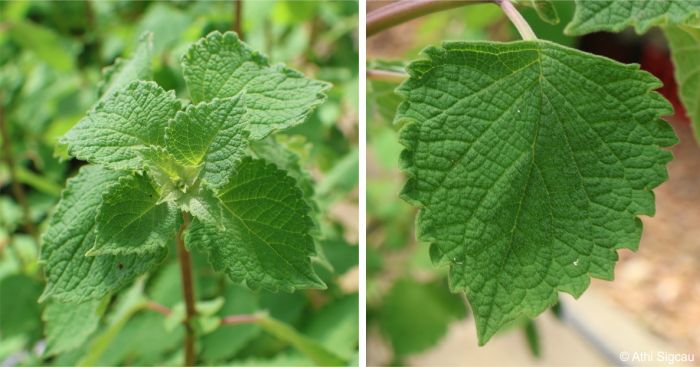
The flowers are without a stalk (sessile) and form a short, terminal raceme 70–90 mm long with, the rachis sometimes branched at the base. The corolla is pink to mauve, with a straight tube 9–10 mm long, 3 mm wide, compressed on the sides and with a swollen base. Flowering time is in autumn (March and April).
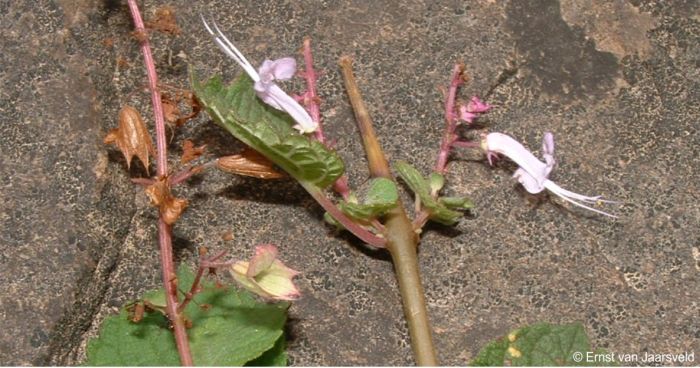
Plectranthus mzimvubuensis is closest to P. reflexus but can be distinguished from P. reflexus by its much shorter corolla (that of P. reflexus is 25 mm long) and much-branched scrambing habit and root tubers where P. reflexus is an erect shrub with fleshy roots. It may be confused with P. ecklonii and P. ambiguus, but can be distinguished by its shorter corolla tube (9–10 mm) compared with the corolla tube of P. ecklonii that is 12–18 mm long and the corolla tube of P. ambiguus is 20–25 mm long.
Conservation Status
Status
Plectranthus mzimvubuensis is assessed as Rare but not threatened by the SANBI Red List of South African Plants. Although it is known to exist in one small population, more may occur elsewhere in similar habitat, and there are no known threats to the plant.
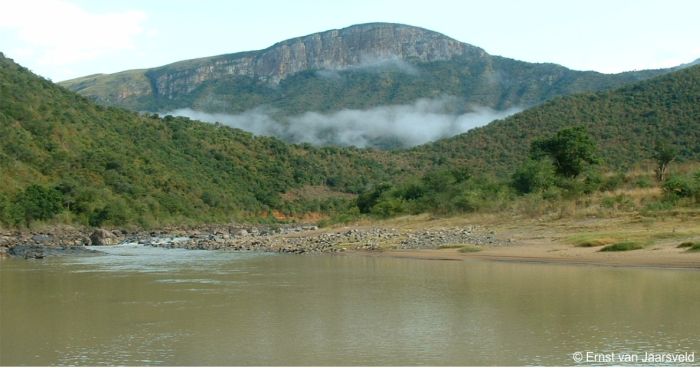
Distribution and habitat
Distribution description
Plectranthus mzimvubuensis grows on south-facing cliffs in light shade, along the Mzimvubu River in Mpondoland, Eastern Cape. The cliffs are Ecca Shale and the vegetation type in this area is Arid Savanna and Valley Bushveld, with a subtropical climate and summer rainfall of 1 000–1 250 mm per annum, hot summers and dry, sunny, frost-free winters. It shares its habitat with Adromischus cristatus, Bulbine latifolia, Crassula cordata, Crassula cultrata, Crassula orbiculata, Cyanotis speciosus, Delosperma tradescantoides and Peperomia blanda.
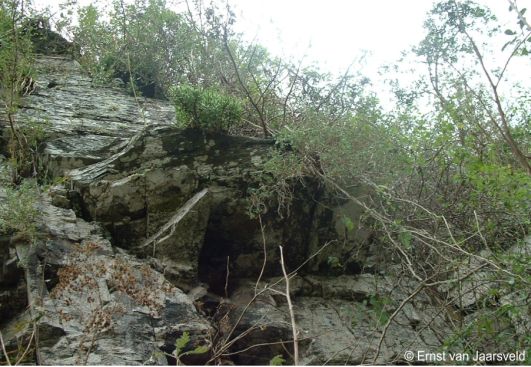
Derivation of name and historical aspects
History
The genus name Plectranthus comes from the Greek words plektron meaning ‘a spur’ and anthos, ‘flower’, referring to the spur that is found at the base of the corolla tube in the type species for this genus. This species is named after the Mzimvumbu River, where this species occurs. This is a Xhosa name meaning ‘the home of hippopotamus’, indicating that hippos were once found in this river.
This species was discovered during a rubber canoe expedition down the Mzimvubu River in Mpondoland in 2002, led by Ernst van Jaarsveld, accompanied by Adam Harrower, Phakamani Xaba and Godfrey Zwide. Plants were brought back and cultivated in Kirstenbosch, confirming it to be a species new to science, and Ernst van Jaarsveld, named and described it in 2004. Mpondoland is recognised as a centre of plant endemism and is home to many endemic species, including this Plectranthus. Because the region is not fully explored, botanically, it is very possible that this species may exist in similar habitats near the place where it was discovered.
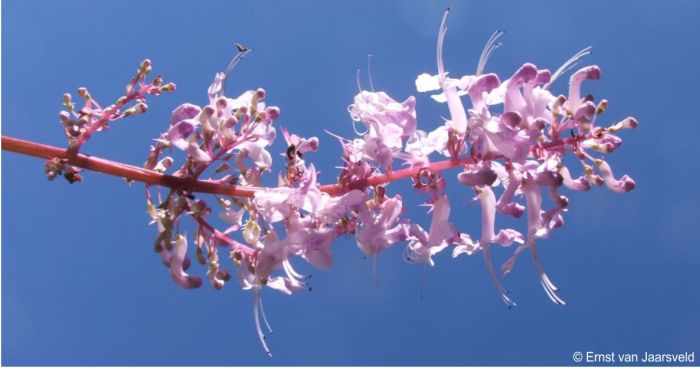
Ecology
Ecology
The flowers of plectranthus are showy, attracting pollinators such as bees, flies and butterflies. The narrow tubular shape of the flowers indicates that they are pollinated by insects with a proboscis, such as the nemestrinid flies. Many species appear to have just one specific pollinator, with a proboscis of the same length as the flower tube. In cultivation at Kirstenboch National Botanical Garden, where many species of Plectranthus are used in the garden for their display of autumn flowers, it has been observered that some species cross pollinate with each other, and hybrids have been produced.
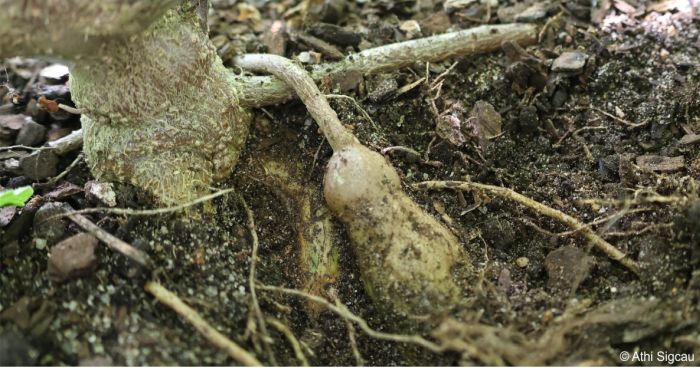
When growing P. mzimbuensis, Ernst van Jaarsveld discovered that this species has root tubers. Tubers allow the plant to adapt to unpredictable environments and ensures resilience from threats such as variable rainfall, grazing, rock falls, as a damaged plant can regenerate from the underground tubers.
Uses
Use
Plectranthus species are used in horticulture as display plants.They are fast-growing, easy to grow and suitable for shade and indoor cultivation. In Kirstenbosch National Botanical Garden many Plectranthus are used as shade plants and grown as forest understory plants because of their decorative foliage and beautiful flowers. Plectranthus mzimvubuensis is frost sensitive and best suited to moist to dry bushveld and thicket gardens, or containers.
Although there are no recorded medicinal uses for Plectranthus mzimvubuensis, many species of Plectranthus are used in traditional medicine; their stems, leaves, roots and tubers are used to make medicine such as syrups, ointments and oils to treat colds and some species are used as charms.
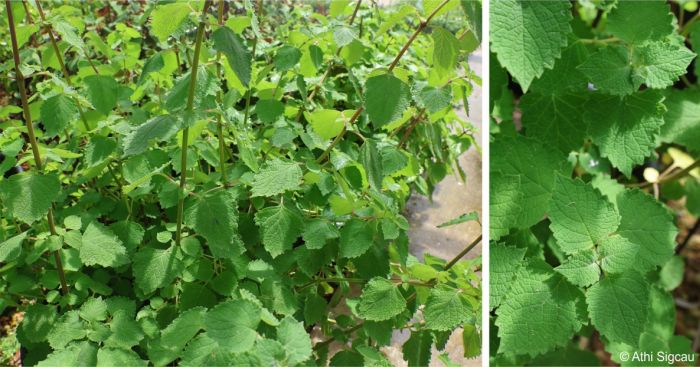
Growing Plectranthus mzimvubuensis
Grow
Plectranthus mzimvubuensis is easy to propagate through asexual propagation. Take cuttings from the mother plant, whether it is stem cuttings, tip cuttings or heel cuttings. Follow the general procedure for making cuttings, cut below a node and remove two thirds of the leaves. You can use rooting hormone for soft cuttings to help with quicker rooting, but Plectranthus species can root without the use of a rooting hormone. The stem of Plectranthus mzimvubuensis is semi succulent and sensitive when cut, therefore, sterilize your cutting tool when making cuttings, to eliminate infections and ensure a high survival rate of your cuttings. A fast-draining rooting medium mix of sand, fine-milled bark or vermiculite is used at Kirstenbosch NBG when growing the cuttings. Place the cuttings tray in a well-ventilated, shaded location and water once a day or more if necessary during extremely hot weather. Roots will emerge after 3 to 4 weeks, at which point the cuttings can be transplanted into pots containing a potting mix of sand, fine-milled bark and compost. This species of Plectranthus is also propagated through division.
Plectranthus is seldom propagated from seeds because cuttings grow very easily and seed-grown plants take longer to grow. The seeds are sown in early summer, in a mix of sand, fine-milled bark and compost, then covered with a thin layer of fine-milled bark. Water consistently until the seedlings are ready to be potted.
Plectranthus mzimvubuensis is shade loving and grows best in a well-drained soil. Pruning is done yearly, just after flowering is finished. The plant is cut back to reduce the height and to promote the growth of new healthy shoots. Old, dead branches are cut off and any pests or diseased branches removed. Water adequately and take care not to over water as the stems of Plectranthus will rot in soggy, poorly drained soil. In the garden, Plectranthus, should be watered once or twice a week, depending on the weather. When growing Plectranthus in the garden, one needs to consider the plant’s height and width. A spacing of 60 cm is recommended when mass planting to get the best effect when in flower.
Plectranthus species are not highly infested with pests, but with some species, like Plectranthus oertendahlii, the roots are attacked by microscopic eelworm which prevents the plant from taking up water and nutrients. Infected plants should be removed and the soil replaced. A common pest is the mealybug which can be seen behind the leaves and on the stems, especially on the juvenile plants. Common fungal diseases are rust and blight and root rot can also occur especially when cuttings or plants are over watered. Good nursery hygiene should prevent these problems.
References
- Busch, B. 2013-09. Plectranthus ciliatus E.Mey. ex Benth. (Lamiaceae). PlantZAfrica. Online. https://pza.sanbi.org/plectranthus-ciliatus.
- Jodamus, N. & Notten, A. 2002-04. Plectranthus fruticosus L'Hérit. ‘James’. (Lamiaceae). PlantZAfrica. Online. https://pza.sanbi.org/plectranthus-fruticosus-james.
- Johnson, I. 2007-01. Plectranthus zuluensis T.Cooke. (Lamiaceae). PlantZAfrica. Online. https://pza.sanbi.org/plectranthus-zuluensis.
- Manyama, P.A. 2007. Plectranthus mzimvubensis Van Jaarsv. National Assessment: Red List of South African Plants. http://redlist.sanbi.org/species.php?species=1671-134.
- Potgieter, C., Edwards, T. & Van Staden, J. 2009. Pollination of Plectranthus spp. (Lamiaceae) with sigmoid flowers in southern Africa. South African Journal of Botany 75(4):646–659.
- Rankel, K. 2024. Plectranthus roots 101. Greg App. Online. https://greg.app/plectranthus-roots/.
- Rice, L.J., Brits, G.J., Potgieter, C.J. & Van Staden, J. 2011. Plectranthus: a plant for the future? South African Journal of Botany. 77(4): 947–959.
- Van Der Walt, L. 2008-05. Plectranthus oertendahlii T.C.E.Fr. (Lamiaceae). PlantZAfrica. Online. https://pza.sanbi.org/plectranthus-oertendahlii.
- Van Jaarsveld, E. 2006. The southern African Plectranthus and the art of turning shade to glade. Fernwood Press, Vlaeberg, Cape Town.
- Van Jaarsveld, M. & Van WYK, A.E. 2004. Plectranthus mzimvubuensis. A new species from Eastern Cape. South Africa. Bothalia 34(1):30–32.
Credits
Athi Sigcau and Alice Notten
Kirstenbosch National Botanical Garden
January 2025
Acknowledgements: the authors thank Mpendulo Gabayi for his unfailing support, and Ernst van Jaarsveld for providing images of the plant in flower and its natural habitat.
Plant Attributes:
Plant Type: Perennial, Scrambler, Shrub
SA Distribution: Eastern Cape
Soil type: Sandy, Loam
Flowering season: Late Summer, Autumn
PH: Acid
Flower colour: Pink, Mauve/Lilac
Aspect: Morning Sun (Semi Shade), Afternoon Sun (Semi Shade)
Gardening skill: Easy
Special Features:
Horticultural zones
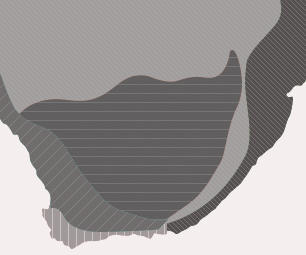






Rate this article
Article well written and informative
Rate this plant
Is this an interesting plant?
Login to add your Comment
Back to topNot registered yet? Click here to register.